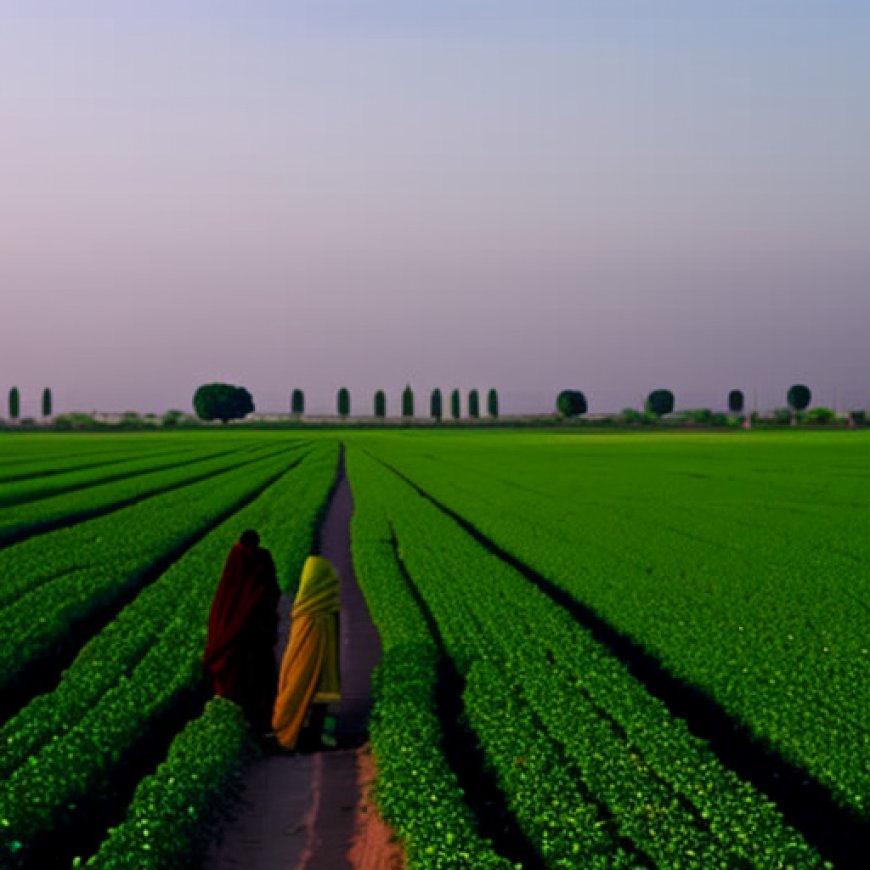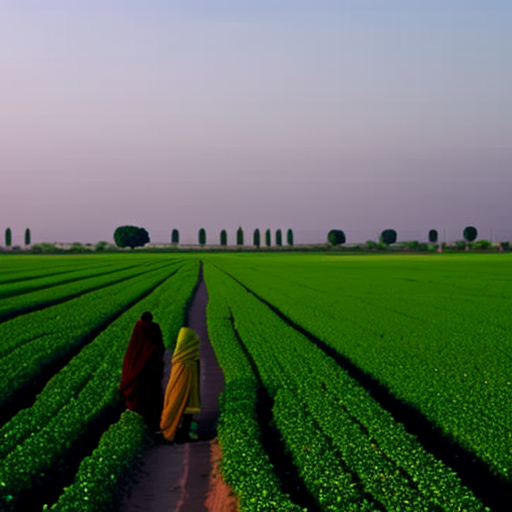Pakistan’s agricultural heartland at risk: Concerns mount as Punjab’s farmland gives way to housing development
Pakistans agricultural heartland at risk: Concerns mount as Punjabs farmland gives way to housing development Geo News


Ishfaq Jutt and the Shrinking Agricultural Land in Punjab
Ishfaq Jutt, a wheat farmer residing in the Southern Punjab city of Jahanian, finds himself in a state of desperation.
With his income plummeting by 45% in the past decade, Jutt eagerly awaits offers from local real-estate developers to purchase his agricultural land.
“All the farmers around me are doing the same,” he tells Geo.tv over the phone, “I plan to sell the land and use the money to set up a business for my children.”
Jutt, a third-generation farmer, inherited his 10-acre farmland from his ancestors dating back to pre-partition times. However, he has no intention for his children to continue his legacy.
The Struggle for Small-Scale Farmers
In Pakistan, farming is now a struggle for small-scale farmers like Jutt.
Persistent inflation has been driving up prices of pesticides, fertilisers and machinery, exacerbating the financial burden for farmers and squeezing their profit margins.
Moreover, the unpredictability of weather patterns have also wreaked havoc on crop yields in the last decade. Pakistan is ranked as the fifth most climate-vulnerable country in the world, according to the Global Climate Risk Index published by a non-profit group Germanwatch.
Pakistan’s Economic Survey for the financial year 2022-23, released by the ministry of finance, also noted that in the last couple of years the country has witnessed climatic shocks, which have adversely affected its agricultural sector.
“The [agricultural] sector’s productivity is highly sensitive to the frequency of adverse climatic events like flood and drought along with abnormal heat waves, rain, and glacial melt,” it added.
Today, farmers end up spending more out of their pockets than they earn.
“So tell me, what’s the point [of farming]?” Jutt asks.
This sentiment resonates with many others in the farming community, which is why in the Punjab province, a growing number of farmers are willingly selling their agricultural land to real-estate developers. While others are being compelled to give up their land for state housing projects.
In either case, the end result is the same: agricultural land is shrinking.
How much land has Punjab lost?
According to official statistics, agriculture is a significant industry in Pakistan and the main driver of its economy. It contributes over 22% to the GDP and provides employment to 47% of the population, with Punjab playing a pivotal role as the nation’s breadbasket.
But in recent years, major cities in the province – Lahore, Faisalabad, Gujranwala, Multan and Rawalpindi – have lost tens of thousands of acres of farmland to public and private housing societies, found The Urban Unit, an autonomous research department of the government of Punjab.
“In Lahore alone, since 2000 over 35% of agricultural land has been converted to brown areas,” Samiullah Khan, manager remote sensing at the Urban Unit, told Geo.tv.
- Crop land in Lahore that was converted to built-up area between 1995 and 2022. — Data via Urban Unit
Mapping conducted by The Urban Unit indicates that a substantial portion of this land in and around Lahore has been swallowed up by three prominent housing societies: the military-run Defence Housing Authority (DHA) and the privately-owned Lake City and Bahria Town.
Today, the DHA Lahore alone stretches to over 300,000 kanals of land and is divided into 12 phases, according to its official website.
- A satellite image of agricultural land in a part of Lahore, captured in 2003 (left). The same agricultural land was later converted to DHA Phase 6 (right). Satellite image taken in 2023. — Data via Urban Unit
Geo.tv reached out to the DHA Lahore office multiple times via calls and an email, but it could not get a response till the filing of this report.
Besides the prominent housing societies, numerous others are also encroaching upon green areas within the city. Around 380 private housing societies are operational in the Lahore district, while 156 have been established illegally, as per a report published by the government-run Lahore Development Authority (LDA).
“There is barely any agricultural land left in Lahore,” remarks Dr Urooj Saeed, a senior specialist at The Urban Unit, “If you look at the city’s recent maps, only around 10 square kilometers of [green] land is left, which is located near the international border [between India and Pakistan].”
Now, even cultivated land on Lahore’s peripheries is being eyed by the government.
In 2020, the federal government announced plans to construct a new city, known as the Ravi Riverfront City, along the banks of the river Ravi. Envisioned to cover an expansive 900 square kilometers, this new city aims to accommodate over 10 million people.
For comparison, the population of Lahore is 13 million, while it measures a little over 1,700 square kilometers.
- A map of the Ravi Riverfront City being built by the government to house over 10 million people along the banks of Ravi. — Map via the website of the Ravi Riverfront City project
“All this land [for the Ravi Riverfront City], more than 90% is prime agricultural land,” an senior government official, privy to the developments told Geo.tv, on the condition of anonymity, “Here wheat, rice and vegetables were grown for Lahore. Now, Lahore will have to get its vegetables from further away and that means higher food costs.”
To acquire land for the project, state officials have been employing a 1894 law, called the Land Acquisition Act, forcibly evicting farmers and residents from their homes. Some farmers have challenged these actions in court.
Multan, another significant urban center in Punjab, shares a similar plight.
From 1995 to 2022, the city has lost 94.5 square kilometers of cropland, nearly ten times the city of Chichawatni in the Sahiwal district of Punjab.
Known for cultivating major crops such as wheat, cotton, sugarcane, as well as mangoes and potatoes, Multan saw a
SDGs, Targets, and Indicators
SDGs Addressed or Connected to the Issues Highlighted in the Article:
- SDG 2: Zero Hunger
- SDG 11: Sustainable Cities and Communities
- SDG 13: Climate Action
- SDG 15: Life on Land
Specific Targets Based on the Article’s Content:
- Target 2.4: By 2030, ensure sustainable food production systems and implement resilient agricultural practices that increase productivity and production, that help maintain ecosystems, that strengthen capacity for adaptation to climate change, extreme weather, drought, flooding and other disasters, and that progressively improve land and soil quality.
- Target 11.1: By 2030, ensure access for all to adequate, safe and affordable housing and basic services and upgrade slums.
- Target 13.1: Strengthen resilience and adaptive capacity to climate-related hazards and natural disasters in all countries.
- Target 15.1: By 2020, ensure the conservation, restoration and sustainable use of terrestrial and inland freshwater ecosystems and their services, in particular forests, wetlands, mountains and drylands, in line with obligations under international agreements.
Indicators Mentioned or Implied in the Article:
- Indicator 2.4.1: Proportion of agricultural area under productive and sustainable agriculture.
- Indicator 11.1.1: Proportion of urban population living in slums, informal settlements or inadequate housing.
- Indicator 13.1.1: Number of deaths, missing persons and directly affected persons attributed to disasters per 100,000 population.
- Indicator 15.1.1: Forest area as a proportion of total land area.
Table: SDGs, Targets, and Indicators
| SDGs | Targets | Indicators |
|---|---|---|
| SDG 2: Zero Hunger | Target 2.4: By 2030, ensure sustainable food production systems and implement resilient agricultural practices that increase productivity and production, that help maintain ecosystems, that strengthen capacity for adaptation to climate change, extreme weather, drought, flooding and other disasters, and that progressively improve land and soil quality. | Indicator 2.4.1: Proportion of agricultural area under productive and sustainable agriculture. |
| SDG 11: Sustainable Cities and Communities | Target 11.1: By 2030, ensure access for all to adequate, safe and affordable housing and basic services and upgrade slums. | Indicator 11.1.1: Proportion of urban population living in slums, informal settlements or inadequate housing. |
| SDG 13: Climate Action | Target 13.1: Strengthen resilience and adaptive capacity to climate-related hazards and natural disasters in all countries. | Indicator 13.1.1: Number of deaths, missing persons and directly affected persons attributed to disasters per 100,000 population. |
| SDG 15: Life on Land | Target 15.1: By 2020, ensure the conservation, restoration and sustainable use of terrestrial and inland freshwater ecosystems and their services, in particular forests, wetlands, mountains and drylands, in line with obligations under international agreements. | Indicator 15.1.1: Forest area as a proportion of total land area. |
Analysis
1. Which SDGs are addressed or connected to the issues highlighted in the article?
The issues highlighted in the article are connected to the following SDGs:
- SDG 2: Zero Hunger – The loss of agricultural land poses a threat to food security.
- SDG 11: Sustainable Cities and Communities – The conversion of agricultural land to housing developments affects access to adequate housing and urban planning.
- SDG 13: Climate Action – Climate-related hazards and natural disasters impact agricultural productivity and land use.
- SDG 15: Life on Land – The loss of productive land leads to a reduction in green spaces, biodiversity, and ecosystem services.
2. What specific targets under those SDGs can be identified based on the article’s content?
Based on the article’s content, the following specific targets can be identified:
- Target 2.4: By 2030, ensure sustainable food production systems and implement resilient agricultural practices that increase productivity and production, that help maintain ecosystems, that strengthen capacity for adaptation to climate change, extreme weather, drought, flooding and other disasters, and that progressively improve land and soil quality.
- Target 11.1: By 2030, ensure access for all to adequate, safe and affordable housing and basic services and upgrade slums.
- Target 13.1: Strengthen resilience and adaptive capacity to climate-related hazards and natural disasters in all countries.
- Target 15.1: By 2020, ensure the conservation, restoration and sustainable use of terrestrial and inland freshwater ecosystems and their services, in particular forests, wetlands, mountains and drylands, in line with obligations under international agreements.
3. Are there any indicators mentioned or implied in the article that can be used to measure progress towards the identified targets?
The article mentions or implies the following indicators that can be used to measure progress towards the identified targets:
- Indicator 2.4.1: Proportion of agricultural area under productive and sustainable agriculture.
- Indicator 11.1.1: Proportion of urban population living in slums, informal settlements or inadequate housing.
- Indicator 13.1.1: Number of deaths, missing persons and directly affected persons attributed to disasters per 100,000 population.
- Indicator 15.1.1: Forest area as a proportion of total land area.
These indicators can provide insights into the state of sustainable food production systems, access to adequate housing, resilience to climate-related hazards, and conservation of terrestrial ecosystems.
Behold! This splendid article springs forth from the wellspring of knowledge, shaped by a wondrous proprietary AI technology that delved into a vast ocean of data, illuminating the path towards the Sustainable Development Goals. Remember that all rights are reserved by SDG Investors LLC, empowering us to champion progress together.
Source: geo.tv

Join us, as fellow seekers of change, on a transformative journey at https://sdgtalks.ai/welcome, where you can become a member and actively contribute to shaping a brighter future.







